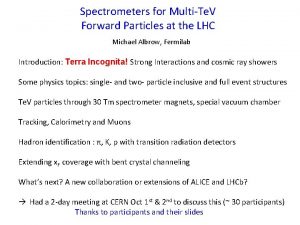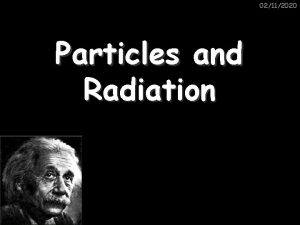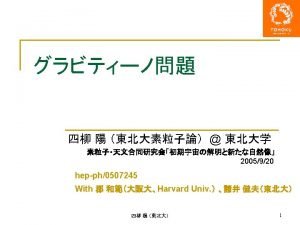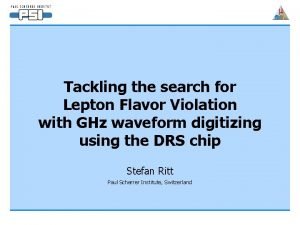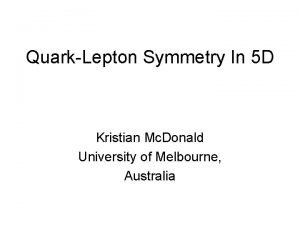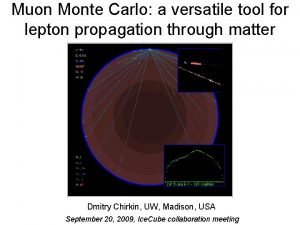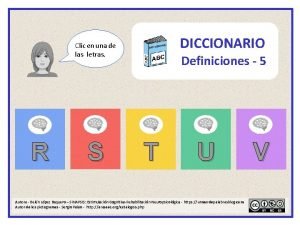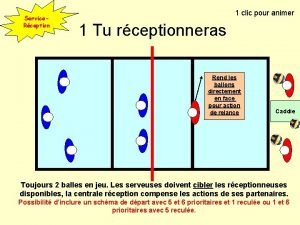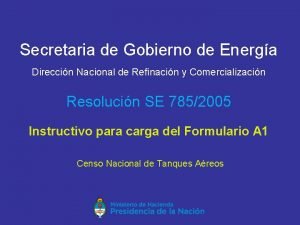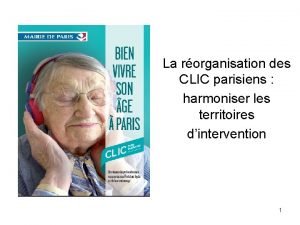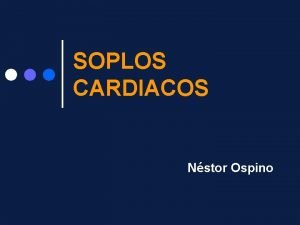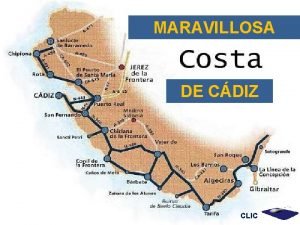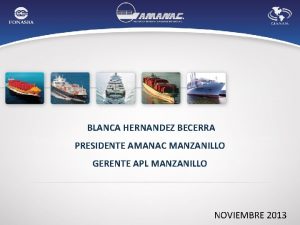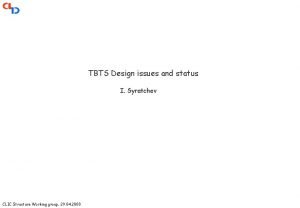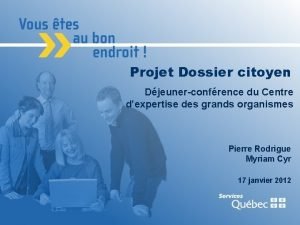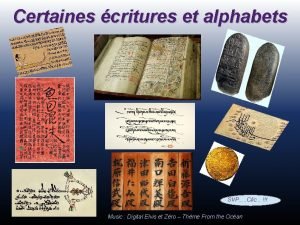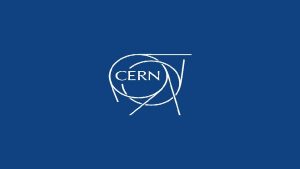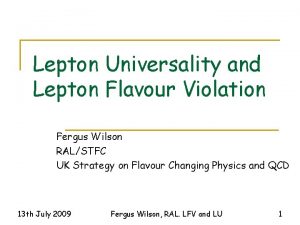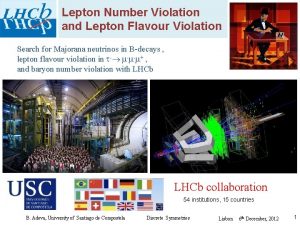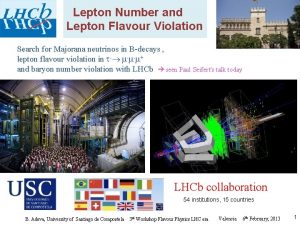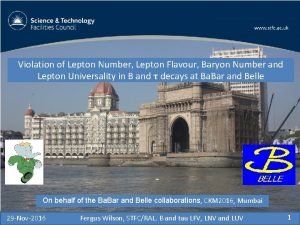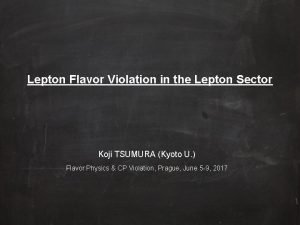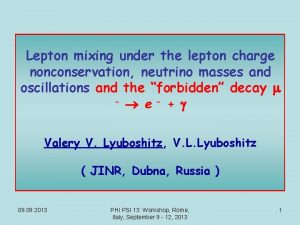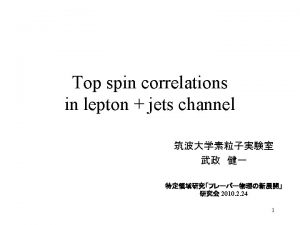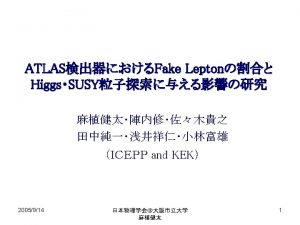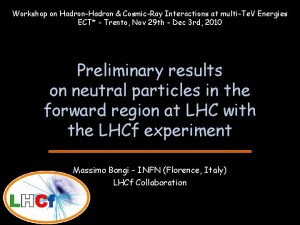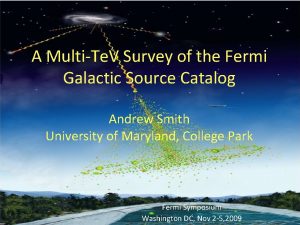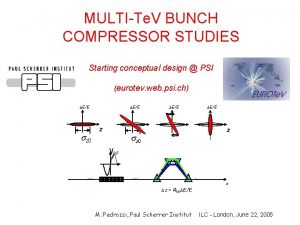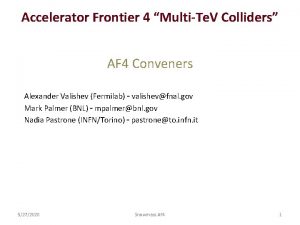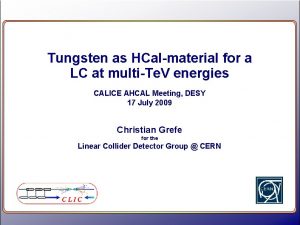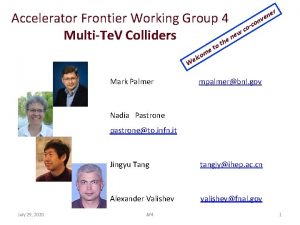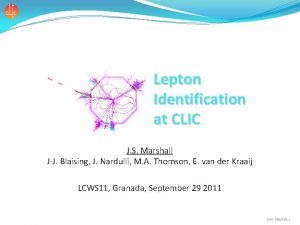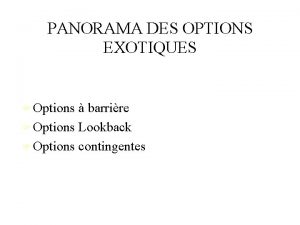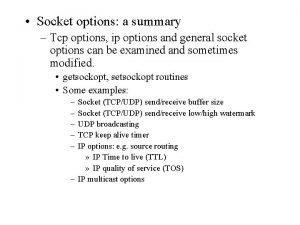CLIC and Other Options for MultiTe V Lepton

































- Slides: 33

CLIC and Other Options for Multi-Te. V Lepton Physics Tor Raubenheimer Accelerator Research Division Head, SLAC P 5 Meeting Fermilab February 1 st, 2008 Tor Raubenheimer

Introduction • Outline – – CLIC concept (X-band Two-Beam Accelerator) Technology status Outstanding issues LC roadmap and other options • Assumptions – Believe that the motivation for Te. V-scale LC remains the same but timescale is slower, motivating a broad look at LC technology • Caveats – Evaluation of outstanding issues for CLIC design is my opinion – Suggestions for ‘other options’ is also my opinion • These views are not endorsed by SLAC, the GDE, or … • I (and SLAC) are committed to developing the ILC as the near-term solution for a 500 Ge. V LC February 1 st, 2008 Page 2 Tor Raubenheimer

What is CLIC? • CLIC = Compact LInear Collider – Developed by CERN originally as a 30 GHz and 150 MV/m that is based on a two-beam accelerator concept • Two-beam concept is an efficient way to transform rf frequency from long-pulse low-frequency short-pulse high-frequency and thereby drive high gradients • Concept is elegant but still waiting for demonstrations and detailed costs illustrating the benefits – Developed parameters from 500 Ge. V 3 Te. V • Recently changed parameters to 12 GHz and 100 MV/m to reduce cost and better utilize GLC/NLC R&D – Development program to demonstrate ~100 MV/m by 2010 – CTF 3 test facility should demonstrate TBA concept on a similar timescale February 1 st, 2008 Page 3 Tor Raubenheimer

Two-Beam Accelerator Concept (from R. Corsini; 2006 parameters) February 1 st, 2008 Page 4 Tor Raubenheimer

Ma in CLIC RF Module ~ 2 meters Be am Dr iv e. B ea m ~1 Accelerating structure, A +100 MV/m, 64 MW, 229 mm 10 0 A rf distribution Power Extraction Structures: -6. 5 MV/m, 136 MW, 210 mm February 1 st, 2008 Page 5 Tor Raubenheimer

CLIC Schematic (2007 Parameters for 3 Te. V) Similar number of klystrons as 500 Ge. V ILC Drive beam complex efficiently generates high power beam Main linacs have deccelerator structures adjacent to accelerator structures in single tunnel – all LLRF and complicated electronics are elsewhere February 1 st, 2008 Page 6 Injector systems similar to other LC concepts Tor Raubenheimer

CLIC Linear Collider Parameters February 1 st, 2008 Page 7 Tor Raubenheimer

Possible CLIC Siting Option CERN site Prevessin IP under CERN Prevessin site Phase 1: 1 TEV extension 19. 5 km Phase 2: 3 Te. V extension 48. 5 km st February 1 , 2008 Page 8 Detectors and Interaction Point Tor Raubenheimer

Proposed Timescale (from JPD presentation to CERN SPC) February 1 st, 2008 Page 9 Tor Raubenheimer

Cost for TBA versus Conventional LC • Major study needed as part of CLIC CDR but characteristics can be understood. The TBA has a large central infrastructure that generates drive beam – Cost per Ge. V of TBA is likely cheaper than that of a conventional klystron-based linear collider – Initial cost of the TBA is higher than that of a klystron-based collider – Location of cross-over and slopes is unknown for present technologies February 1 st, 2008 Page 10 From 1998 comparison of 1996 NLC versus X-band TBA costs by G. Loew Cms Ge. V Tor Raubenheimer

GLC/NLC >50 MV/m Operation Breakdown Rate at 60 Hz (#/hr) with 400 ns Pulses Single Structures Eight Structure Average NLC/GLC Rate Limit Breakdown performance continued to improve with time BDR ~ exp(- t / 400 hrs) over the 2000 hrs operation February 1 st, 2008 Unloaded Gradient (MV/m) Page 11 Tor Raubenheimer

100 MV/m Structure testing at NLCTA (Structures from GLC/NLC program in early 2000’s) • Run slotted, a/l = 0. 18, 75 cm NLC structure (H 75 vg 4 S 18) with 150 ns pulses - at 102 MV/m, breakdown rate = 6 10 -6 • Run early NLC, non-slotted, 53 cm, smaller aperture (a/l = 0. 13) structure (T 53 vg 3 MC) at short pulses – unloaded gradient at a 10 -6 breakdown rate with 100 ns pulses is 105 MV/m and more recently it achieved similar gradient with 200 ns ramped pulse. • Building CERN-designed structures for future tests at SLAC and KEK February 1 st, 2008 Page 12 Tor Raubenheimer

Single Cell Accelerator Structure Testing (Understand Fundamental Breakdown Limits) Goals • Study rf breakdown in practical accelerating structures: dependence on circuit parameters, materials, cell shapes and surface processing techniques Difficulties • Full scale structures are complex and expensive Solution • Single cell Traveling wave (TW) and single cell standing wave (SW) structures with properties close to that of full scale structures This program, now, has a strong participation from both KEK and CERN. Time of flat pulse after filling time Variety of Single Cell Accelerator Structures Manufactured KEK February 1 stat , 2008 SW accelerator structure test with a/l~0. 21. In this type of structures loaded and. Tor unloaded gradients are the same Page 13 Raubenheimer

CTF 3 – CLIC Test Facility • Large-scale LC test facility to demonstrate TBA concept 2004 2005 Thermionic gun Linac DL CR 2007 Photo injector / laser tests from 2008 30 GHz production (PETS line) and test stand CLEX 2007 -2009 building in 2006/7 TL 2 2007 -2008 Beam up to here 150 Me. V 30 Major milestones in 2007: Combiner Ring (CR) installed CLEX building started Februaryfinished, 1 st, 2008 equipment Pageinstallation 14 Tor Raubenheimer A - 140 ns

RF Unit Demonstrations (What is necessary before construction? ) • The ‘RF Unit’ is the acceleration element that is replicated through the main linacs – Usually thought of as the minimal element that needs demonstration before construction -- CLIC is different – In GLC/NLC: two 75 -MW klystrons, SLED-II rf pulse compression system and 4. 8 meters of accelerator structure operating at 50 MV/m loaded ~250 Me. V per rf unit • Pieces demonstrated in 2004; System demo canceled – In ILC: a modulator and klystron, an rf distribution system, and 3 cryomodules with 26 1 -meter rf cavities operating at 31. 5 MV/m ~1 Ge. V per rf unit • Pieces to be demonstrated in 2010; System demo in ~2012 – In CLIC: a 2. 5 Ge. V 100 Amp drive beam is fed into ~600 meters of decellerator structures that accelerate the primary by ~60 Ge. V • Pieces in 15 ~2012 in CTF 3 no RF Unit demo February 1 st, demonstrated 2008 Page Torbut Raubenheimer

Outstanding Issues for CLIC • Program to develop high-gradient accelerator structures by 2010 – May not achieve 100 MV/m at desired breakdown rate but, given present results, will probably be close • Systematic cost estimate needed – Working with GDE to develop costs using same methodology as applied to ILC – aiming for 2010 -timescale • Tighter alignment and jitter tolerances – Aiming to demonstrate stabilization techniques by 2010 • Program to demonstrated TBA-concept in CTF 3 by 2012 and accelerate beams to ~1 Ge. V – Concept demonstrated but drive beam parameters quite different from CLIC and will not demonstrate an ‘RF Unit’ • Not clear what is necessary to launch construction and the collaboration is discussing options Tor Raubenheimer February 1 st, 2008 Page 16

Understanding the Gradient Choice G = A sqrt(P * Rs) P = rf power / meter Rs = shunt imp. / m Relative TPC • Cost optimum is a balance between costs proportional to length, i. e. tunnel & structures and costs GLC/NLC X-band proportional to the rf At low gradient, cost power sources increases due to larger • Have to reduce rf power cost per MW by 2 x or double shunt imped. to increase G by 40% February 1 st, 2008 Page 17 length costs At high gradient, cost increases due to higher rf power costs Unloaded Gradient (MV/m) Tor Raubenheimer

CLIC Gradient Optimization • CERN developed a detailed cost estimate using the TESLA estimate and the US Technical Options Study (2003) costing – Not entirely clear what is included and what drives the frequency scaling but the basic form makes sense – Believe that there is an assumption that above 10 GHz, the gradient is independent of frequency – Main point: very high gradients don’t make cost sense February 1 st, 2008 Page 18 Cost Previous New Optimum Tor Raubenheimer

Approaches to a Linear Collider (Four Options) • Superconducting rf (1. 3 GHz) – Strong international support through ILC collaboration – Gradients of 30 MV/m in cavities yielding 20 MV/m average – Technology well advanced (1 Ge. V test facilities under construction at Fermilab and KEK 2011 or 2012) – Can be stretched to ~1 Te. V energy • Normal conducting rf (11 ~ 12 GHz) – Strong international support through CLIC collaboration • CLIC recently adopted 12 GHz down from 30 GHz – Gradients of 100 MV/m yielding 80 MV/m average – Technology fairly well advanced (test facility at SLAC demonstrated 300 Me. V at 50 MV/m in 2004 and CTF 3 at CERN aiming for 1 Ge. V at 100 MV/m in 2012 - 2014) – Certainly reach 1 Te. V and maybe multi-Te. V energies February 1 st, 2008 Page 19 Tor Raubenheimer

Approaches to a Linear Collider (2) (Four Options) • Normal Conducting rf (cont. ) – Two NC rf source concepts have been considered: • Klystron-based linacs with klystrons along accelerator • Two-Beam accelerator with drive beam powering linac • Possible to consider a staged implementation using first klystron-based and then TBA-based rf power to reduce risk • Advanced concepts (laser and plasma) – Small lab and university-based collaborations – Gradients of many Ge. V per meter have been demonstrated – Technology has many challenges – working to develop roadmap illustrating development of acceleration concept and beam quality concepts – Some concepts (PWFA) use conventional rf linacs as drivers or injectors February 1 st, 2008 Page 20 Tor Raubenheimer

A Roadmap for Multi-Te. V Lepton Colliders Normal conducting - Two-Beam-based Multi-Te. V LC Normal conducting – Klystron-based 350 Ge. V LC Plasma Acc 4 th Generation SR Sources Superconducting RF 5 th Generation SR Sources? 500 Ge. V LC The LC roadmap illustrates Neutrino source options and connections between them. Selecting a path requires additional information such as LHC results and technology status Timescale (personal guess) February 1 st, 2008 Multi-Te. V LC 2010 2020 Page 21 2030 Neutrino ring Muon collider (few Te. V) 2040 2050 Tor Raubenheimer

One Possible Path to Multi-Te. V Lepton Physics Normal conducting - Two-Beam-based Multi-Te. V LC Normal conducting – Klystron-based 350 Ge. V LC Plasma Acc 4 th Generation SR Sources Superconducting RF 5 th Generation SR Sources? Multi-Te. V LC 500 Ge. V LC Neutrino source Neutrino ring Muon collider (few Te. V) Timescale (personal guess) February 1 st, 2008 2010 2020 Page 22 2030 2040 2050 Tor Raubenheimer

RF Power Source R&D • Developing rf power sources for ILC: – Marx solid state modulator – broad applicability of technology – Sheet beam klystron – broad applicability of SBK concept • Developed rf power source for GLC/NLC: – SLED-II system delivered >500 MW – Two-Pac modulator fabricated but never tested – halted in 2004 – X-band klystrons operated at 75 MW and 1. 5 us but limited by breakdowns → Consider new output structures or reduced power levels using knowledge from high gradient studies • Future program to complete X-band rf source program – Could provide a more conservative option to CLIC design – Power sources for compact radiation sources and other compact installations February 1 st, 2008 Page 23 Tor Raubenheimer

GLC/NLC RF Power Sources • Good success with modulator, pulse compression and rf distribution development. Klystrons achieved peak power and pulse length specs but BDR was too high Output Power (Gain = 3. 1, Goal = 3. 25) Combined Klystron Power February 1 st, 2008 Page 24 Tor Raubenheimer

Staged Approach to TBA • Should re-optimize the NC rf source but as a start: • Use the (nearly developed) GLC/NLC power source to power the CLIC accelerator structures at a loaded gradient of ~60 MV/m – Need to solve klystron BDR problem but assuming success • Increase gradient by ~20% for same cost per meter • Easy to perform systems demonstration of an rf unit • Simple improvements in pulse compression could increase power per meter 10% cost reduction • Build lowest reasonable energy LC with klystrons – Commission X-band main linac, BDS, sources and detectors – Use infrastructure to start testing TBA drive beam dynamics while operating klystron-based collider and then move to TBA. February 1 st, 2008 Page 25 Tor Raubenheimer

Another Possible Path to Multi-Te. V Lepton Physics Normal conducting - Two-Beam-based Multi-Te. V LC Normal conducting – Klystron-based 350 Ge. V LC Plasma Acc 4 th Generation SR Sources Superconducting RF 5 th Generation SR Sources? Multi-Te. V LC 500 Ge. V LC Neutrino source Neutrino ring Muon collider (few Te. V) Timescale (personal guess) February 1 st, 2008 2010 2020 Page 26 2030 2040 2050 Tor Raubenheimer

Comment on Spin-off Applications Both NC and SC rf technology have many additional applications Normal conducting RF • • Compact high gain FELs Storage ring injectors Medical linacs Industrial radiation sources Superconducting RF • High gain FELs • Recirculating linacs and CW applications • Industrial accelerators (no present applications) • To date, NC technology has been simpler and cheaper to implement (at least for small-scale applications) • SC technology is better suited for CW applications and NC is better suited to short high-current beam pulses • Both technologies can have comparable efficiencies and deliver comparable beam power February 1 st, 2008 Page 27 Tor Raubenheimer

Applications Example: High Gain FELs Roughly equal number of normal conducting and superconducting– based FEL sources February 1 st, 2008 Many FELs use higher harmonics for bunch compressions; SLAC was asked to build 12 GHz klystrons for Trieste, Page 28 Frascati and. Tor Raubenheimer PSI

Yet Another Possible Path to Multi-Te. V Lepton Physics Normal conducting - Two-Beam-based Multi-Te. V LC Normal conducting – Klystron-based 350 Ge. V LC Plasma Acc 4 th Generation SR Sources Superconducting RF 500 Ge. V LC PWFA accelerator could likely work with either SC or NC driver linacs – SC option illustrated here. Timescale (personal guess) February 1 st, 2008 5 th Generation SR Sources? Multi-Te. V LC Neutrino source Neutrino ring Muon collider (few Te. V) 2010 2020 Page 29 2030 2040 2050 Tor Raubenheimer

Example: Plasma Wakefield Acceleration (PWFA) • Acceleration gradients of ~50 GV/m (3000 x SLAC) – Doubled energy of 45 Ge. V beam in 1 meter plasma • Major questions remain – Beam acceleration – Emittance preservation – New facilities being developed February 1 st, 2008 Page 30 Tor Raubenheimer

Future PWFA Opportunities A Te. V Plasma Wakefield Accelerator based Linear Collider Single stage afterburner… … or optimized design using low energy bunch train to accelerate single high energy bunch Other applications: • Apply MT/m focusing gradients in plasma ion column to radiation production (Ion Channel Laser) • New phenomena may sources February(trapped 1 st, 2008 electrons) Page 31 offer high brightness Tor Raubenheimer

X-band R&D Funding Requirements • X-band R&D was cut from ~20 M$ / year to ~3 M$ per year after 2004 ITRP decision – 3 M$ / year funds US High Gradient Collaboration pursuing fundamental R&D on structure gradient limitations – US and KEK are working with CERN testing high-gradient structure prototypes. Need additional funds to support this. • Also urge funding for X-band power source R&D in US – Complete GLC/NLC rf power source development to facilitate a staged approach to CLIC while pursuing fundamental R&D on alternate rf power sources – Infrastructure is already in place relatively inexpensive to use; however it will be difficult to maintain capability without a program • Complete R&D program would ramp to ~10 M$ / year – Roughly 20% of projected FY 10 US SCRF and ILC programs February 1 st, 2008 Page 32 Tor Raubenheimer

Summary • Critical time for linear collider R&D program – Science case for a Te. V-scale collider remains strong • Need to consider what we as a community need to do to maintain options for energy frontier lepton probes – Options exist with different reaches, timescales, risks and costs • ILC is the most developed but X-band options also exist • Don’t really know the costs and risks of the different paths – Should have much more information in 2010 ~ 2012 • Develop multiple linear collider technologies: need R&D on SC, NC and advanced acceleration concepts – Great potential & many applications of the technology across science – Strong collaborations with ILC GDE as well as CERN and KEK – Extensive infrastructure exists to support X-band plasma R&D February 1 st, 2008 Page 33 Tor Raubenheimer
 Multite
Multite Neutrino lepton number
Neutrino lepton number Lepton number table
Lepton number table Lepton-photon
Lepton-photon Seth neddermeyer
Seth neddermeyer Quark lepton symmetry
Quark lepton symmetry Lepton tool
Lepton tool Options, futures, and other derivatives
Options, futures, and other derivatives Entrez donc saint nicolas paroles
Entrez donc saint nicolas paroles Double entry sales invoice
Double entry sales invoice Palabras que empiecen con la letra a
Palabras que empiecen con la letra a How to compute net of vat
How to compute net of vat Rception
Rception Sgda 785
Sgda 785 Clic paris emeraude
Clic paris emeraude Clic mesosistolico
Clic mesosistolico Clic
Clic Las siguientes imagenes pueden causar
Las siguientes imagenes pueden causar Clic
Clic Cern clic
Cern clic Clicséqur mon dossier citoyen
Clicséqur mon dossier citoyen Clic music
Clic music Rey orozco
Rey orozco Self-initiated other-repair examples
Self-initiated other-repair examples Fspos
Fspos Typiska drag för en novell
Typiska drag för en novell Nationell inriktning för artificiell intelligens
Nationell inriktning för artificiell intelligens Vad står k.r.å.k.a.n för
Vad står k.r.å.k.a.n för Varför kallas perioden 1918-1939 för mellankrigstiden?
Varför kallas perioden 1918-1939 för mellankrigstiden? En lathund för arbete med kontinuitetshantering
En lathund för arbete med kontinuitetshantering Adressändring ideell förening
Adressändring ideell förening Tidbok
Tidbok Sura för anatom
Sura för anatom Förklara densitet för barn
Förklara densitet för barn
